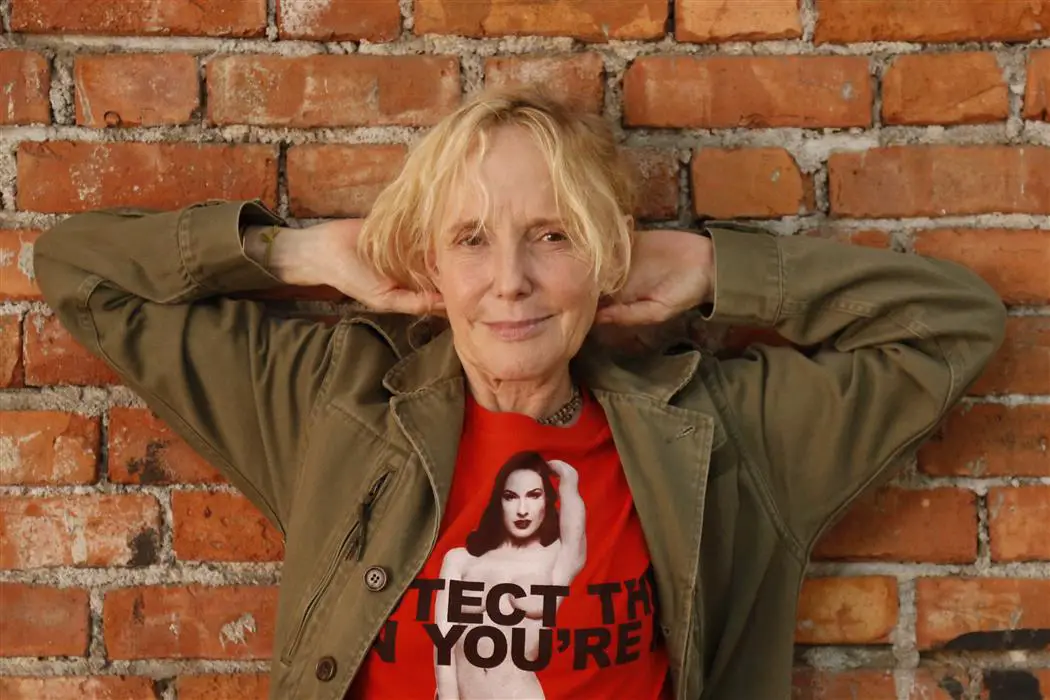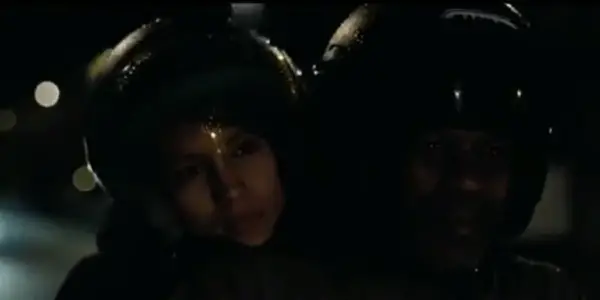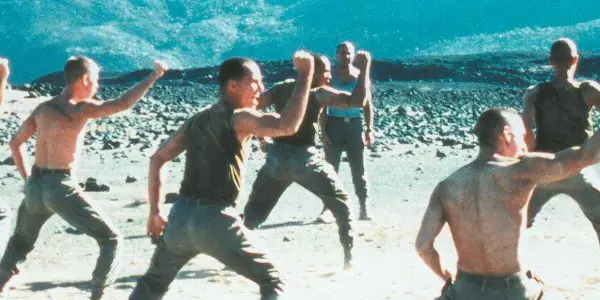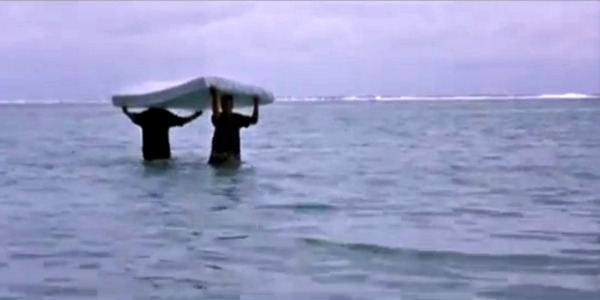The Beginner’s Guide: Claire Denis, Director

Ben is a former student of cognitive science who is…
During a Q&A at the 51st New York Film Festival, Claire Denis was asked why she uses so little dialogue in her films. She responded that she avoids dialogue because she prefers not to structure the cinematography and editing in her films around conversations. She said that avoiding dialogue gives her a freedom with the camera that she prefers, and that when she wants to discuss something in depth, she prefers her characters “monologuing, with everyone just nodding.”
And you will indeed find that Denis’s films contain many scenes characters speaking to other characters without response, or monologuing in voiceover. You’ll also find that she often eschews words altogether. This can make her films less-than-accessible; sometimes, even her most ardent fans think so. But even in those cases, most viewers will at least appreciate the cinematography of her usual cinematographer Agnès Godard, or the richness of her characters’ nonverbal methods of communication: through silent gazes, dimly-lit dances in the middle of the night, and the way they surround themselves with tokens of long-past loves and ambitions.
With this language of personal treasures and human silhouettes, Denis’s films span tenderness and some of the most brutal acts of violence you’re likely to see on the big screen. Her films can handle such a breadth of tone and subject: each of them, in their own way, presents the world as an amalgam of constantly shifting parts, every one of which has a history; and even as we come to understand this, we always remain in contact with the immediacy of tactile experience. You can feel the textures, contours, and temperatures in her films.
Foreign Frustrations
Denis was born in 1946, the daughter of a French bureaucrat whose work brought her family to West Africa, where they moved frequently between countries during Denis‘s childhood. She returned to France after she and her sister contracted polio, and she became an avid film watcher at an early age. Eventually, after abandoning other pursuits in higher education, she enrolled at the Institut de hautes études cinématographiques. She never released a feature until 16 years after her graduation, but worked with a variety of major directors in the interim, from the radical Dusan Makavejev to the subtle, quirky Jim Jarmusch.
According to Denis, the commonalities between her films aren’t deliberate, but many critics claim they share themes of foreignness, unstable identities, and border-crossing (in both a personal and literal sense). While I wouldn’t dispute this, I’d rather focus here not on these films’ themes, but on how those themes emerge as a natural consequence of how these films have us perceive their worlds.
Again, while her films are beautiful to look at, they can be shockingly violent, and some viewers might find them impenetrable. Fortunately, the variety of her filmography allows first-time viewers to ease themselves into her style of filmmaking, and can give them a chance to make associations that might help them to look at her more abstruse films from novel perspectives.
35 Shots of Rum (2008)

35 Shots of Rum is probably the most accessible of Denis‘s films, and therefore a potentially good starting point; it’s also one of the best. It follows Lionel (Alex Descas, a frequent collaborator), a train operator living in Paris with his adult daughter Josephine (Mati Diop). It’s evident that Josephine will move out to live on her own soon, but they both know they’ll miss each other when she does. The plot consists of little more than that and their interactions with Gabrielle (Nicole Dogue) and Noé (Grégoire Colin, another frequent collaborator), friends of theirs who live in the same apartment complex.
The film takes part in an exploration of each character’s baggage, though not in such a way that we learn much about their pasts. We get bits and pieces, like when Noé reveals his apartment is furnished with mementos from his late parents, or when Josephine digs up old letters and photographs in a fit of anxiety over leaving the aging Lionel to live on his own. But mostly we understand their dilemmas through scenes of slow but inexorable forward movement, the way the characters look at each other and huddle together, the winter coats they all wear, and the vaguely mournful background score.
In this film, Denis‘s mysterious-yet-intimate style probes the difficulties of making genuine progress on both a global and personal scale, without ever losing the rhythms of everyday life or keeping the audience at a distance from the characters; in fact, the film’s way of imbuing small things with gravitas makes for one of the most heartrending moments in any movie.
U.S. Go Home (1994)

U.S. Go Home is another decent entry point, seeing as it’s not only relatively accessible but also much less sad than most of Denis‘s other films. It tracks a fairly simple story of two teenage girls living in France who set out to have new experiences and expand their social lives. U.S. Go Home contains a bit more dialogue than most of Denis‘s other films, but also shows more than most of them how the characters’ self-expression manifests in how they move their bodies.
The way light bounces off of couples dancing in the dark articulates this best. It’s this mode of communication that gives rise to uncertainty, introducing interactions that complicate the main characters’ coming of age. It’s a little off-putting, but U.S. Go Home is one of Denis‘s more lighthearted movies, and as the title would suggest, it speaks to a world beyond that of the two girls it focuses on.
Beau Travail (1999)

Beau Travail, by general consensus, is Denis‘s masterpiece. Unlike the two films mentioned above, it feels mythic and overwhelming in scope. It follows a group of French Legionnaires stationed in Djibouti, led by Master Sergeant Galoup. Galoup is played by Denis Lavant, an actor of incredible physical ability (as evidenced by the frenetic dancing at the end of Beau Travail). And the implication of physical strength is essential to Beau Travail‘s imagery: its most memorable scenes are those of the soldiers exercising in unison, almost dancing, while opera music swells in the background.
The film begins with Galoup relating the memory of how he was dishonorably discharged from the Legion. Things began to go sour for him after Private Gilles Sentain (Grégoire Colin again) joined his command. Sentain is a model Legionnaire, and well-liked by the others, but Galoup comes to hold a seething, inexplicable hatred for him.
Before, I described Denis‘s films as “tactile.” This isn’t a word I use lightly; while films are good at eliciting emotional responses, it’s quite rare that they give you a strong sense of feeling physical textures. Beau Travail manages it the best out of Denis‘s films, which is saying something. Its lighting, its attention to the human form as the actors contort themselves, and the meticulous detail realized in its editing make some of Beau Travail‘s later scenes – without exaggeration – almost physically painful. At the same time, it’s replete with striking landscapes, though not necessarily beautiful ones: the desert sands are coarse and gray, and many scenes are colored with an uncanny green.
Compared to the two films above, Beau Travail‘s narrative is much murkier. It often meanders and jumps back and forth through time. What’s more, the images don’t cohere so much as clash with each other: you’ll have scenes where the soldiers exercise in unison followed by ones where some are clearly excluded from the group, or even in hostile confrontation with each other. It isn’t for everyone, and even those who enjoy it might find it fares better on rewatches. Even so, I have no reservations in saying that it’s one of the greatest films of recent times.
The Intruder (2004)

Even among people who like Denis‘s films, The Intruder is controversial. Many find it incoherent, and complain that they’re never sure what’s going on (I’ve seen it three times, and even I couldn’t explain the plot clearly). It has some very enthusiastic fans, though, and one of the interesting things about it is that those fans will also tell you they have no idea what happens in it.
Along with the 2001 horror film Trouble Every Day and 2013’s Bastards, The Intruder might be Denis‘s most difficult film. I recommend it here over the other two because Trouble Every Day is extremely violent and Bastards is almost as violent, with an extra helping of general human ugliness. The Intruder is quite violent as well – its most memorable image is an excised human heart resting on a snowy ground – but in a muted way that most people probably won’t find too disturbing. It’s also quite beautiful, immersing the viewer with all kinds of landscapes and cityscapes as it traverses the globe.
The way The Intruder travels around the world has an interesting effect on the viewer, undermining our sense of place and stability. It becomes necessary for us to latch onto the main character’s face and familiar objects to orient ourselves. The few narrative details that come through, however, make us suspicious of these things. The Intruder can be frustrating, but it’s a neat experience.
What the Future Holds
Denis once admitted in an interview that she believed The Intruder would be her last film: it caused her to think about her mortality, and she believed she would die before making another one. She did continue to make films long after that, but at 71 years old, it wouldn’t be surprising if she decided to retire before long. Fortunately, we needn’t worry about that yet. She has a new film coming out this year, and another one planned after that. Her new film, Let the Sunshine In (starring Juliette Binoche and Gerard Depardieu), is, somewhat surprisingly, a romantic comedy. Denis‘s fans seem to appreciate it, though they also note that it’s a bit different from her other films. After that, she hopes to release High Life, her English-language debut. High Life‘s production was delayed for Let the Sunshine In, but is expected to be released within the next two years. It’s to be a sci-fi film starring Robert Pattinson and Patricia Arquette, whose characters are on a spacecraft drifting toward a black hole.
High Life wouldn’t be Denis‘s first sci-fi film (that’d be Trouble Every Day), but it sounds like a departure nonetheless. Still, I have high expectations. Even when working with the same actors time and again, Denis has succeeded with all different kinds of stories and styles of telling them.
Do you find Denis’s films impenetrable? Do they still interest you anyway? Are there any others that might be good entry points for first-time Denis viewers?
Does content like this matter to you?
Become a Member and support film journalism. Unlock access to all of Film Inquiry`s great articles. Join a community of like-minded readers who are passionate about cinema - get access to our private members Network, give back to independent filmmakers, and more.
Ben is a former student of cognitive science who is currently trying to improve his writing style and ability to understand and appreciate films containing unfamiliar perspectives. He tries not to hold films to a strict set of criteria, but does believe that strong movies can change your outlook on the world. His favorite films include Whisper of the Heart, Hellzapoppin', Foolish Wives, 42nd Street, and the work of Charlie Chaplin.













